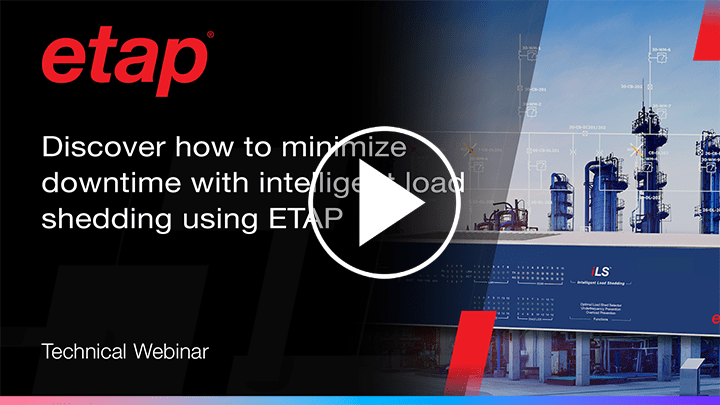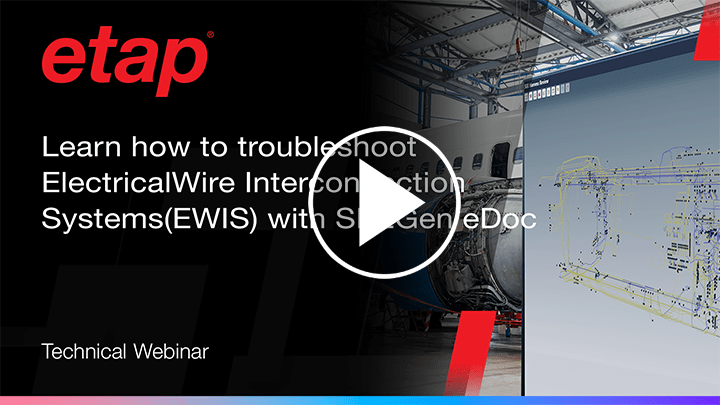288 Item(s) found

Learn how to maximize uptime and optimize microgrid operations
- 20:31
- Webinar
Learn about ETAP Microgrid, an integrated solution used to efficiently evaluate and optimize microgrid systems. The solution enables simulation and hardware-in-the-loop testing for microgrid systems using data-driven technology and built-in functions. This presentation covers the definition of a microgrid, the integration of various energy sources, and the importance of high performance solutions for enhancing energy resilience. Demonstrations of specific scenarios are provided for both grid-tied and off-grid microgrids. The hardware-in-loop testing capabilities are also demonstrated, showcasing the real-time digital simulator and its application for testing and validating microgrid controller functions. By addressing the complexities of microgrid system analysis, management, and control, ETAP Microgrid contributes to cost and time-saving benefits.

Learn how to achieve grid code compliance with ease using ETAP Software
- 19:23
- Webinar
Learn how ETAP Grid Code improves grid interconnection studies and compliance checks. This presentation provides a walkthrough of ETAP’s advanced modeling capabilities and study modules which alleviate the challenges of manual processes, including integration of rulebooks with load flow, short circuit, protective device coordination, transient stability and harmonic analysis. Interconnection studies are vital for the power sector's shift to sustainable energy, ensuring the safe, secure, and efficient operation of connected power plants. By streamlining compliance checks and ensuring that grid code requirements are met, the time-saving solution offered by ETAP offers a much-needed comprehensive solution for grid interconnection studies.
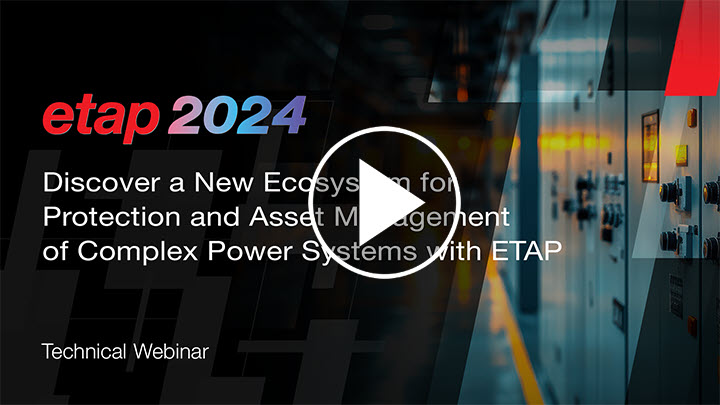
Discover a New Ecosystem for Protection and Asset Management of Complex Power Systems with ETAP
- 18:42
- Webinar
Learn about the unique challenges faced by engineers and operators to ensure the health and maintenance of their electrical systems, and how ETAP’s eProtect protection and asset software, and ETAP Digital Twin enable utilities and power system operators to achieve a higher level of reliability, efficiency, and safety in their operations. You’ll learn how how the effective integration of hardware resolves many of the complexities of relay protection setting management.
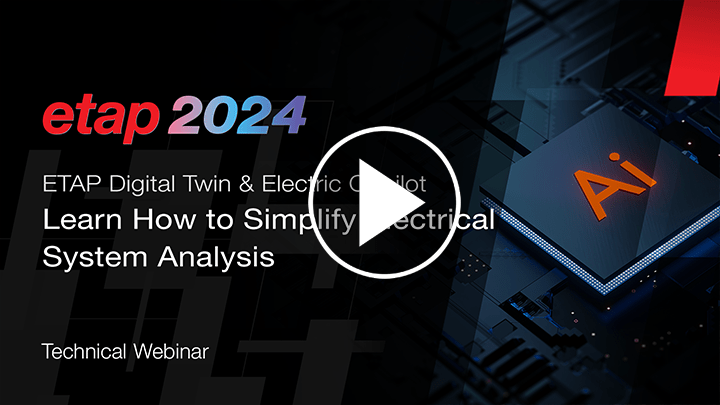
Learn How to Simplify Electrical System Analysis with ETAP Digital Twin & Electric Copilot
- 15:17
- Webinar
Learn how ETAP's Simplified Electrical Digital Twin and Electric Copilot™ are helping to solve the key challenges being faced in electrical design and analysis, such as increasing system complexity, aging infrastructure, demand for real-time data, regulatory pressure, and skill gaps. The product demonstration illustrates the innovative and newest features of ETAP, including new modeling functionality, document tagging, composite networks, component classification, advanced preferences, and artificial intelligence with Electric Copilot.

Learn About Integrating Wind Turbines for FPSO Optimal BESS Sizing using ETAP & PSCAD Co-simulation
- 19:49
- Case Study
The transition towards sustainable energy sources is driving innovative solutions in the offshore oil and gas industry. The presentation delves into the integration of a Wind Turbine Generator (WTG) into an existing Floating Production Storage and Offloading (FPSO) vessel to reduce carbon emissions. The technical and operational challenges of this integration are discussed, including load balancing, intermittency of wind energy, transformer energization, motor starting, protection coordination, and maintaining operational reliability. The study utilizes simulations with tools like HOMERPRO, ETAP, and PSCAD to assess the technical feasibility of integrating the WTG and Battery Energy Storage System (BESS) into the FPSO power system. Various studies, including load flow, short circuit, motor acceleration, transient stability, voltage ride through, harmonic analysis, protection coordination, and transformer energization are conducted to ensure the effectiveness and efficiency of the proposed system. There is great potential for reducing the operational carbon footprint of FPSOs by incorporating renewable energy sources and using software simulations to address the complexities and considerations involved in such integration.

How to Optimize Green Hydrogen Projects Using ETAP and Digital Twin Technology for Efficiency
- 17:24
- Case Study
This case study focuses on a green hydrogen project that applied a digital twin solution. The project is a 1.4 gigawatt wind farm in China, involving green hydrogen and ammonia manufacturing, with an estimated investment of $1-2 billion. The customer recognized the need for a software solution to optimize their processes and was looking for comprehensive coverage from power management to process management. The project's objectives included sizing optimization to reduce CapEx costs, process verification and optimization, and digital tools for control system specifications and electrolyzer selection. The digital continuity and unified digital solution offered by Schneider Electric encompassed feasibility study, detailed design, and future operation and maintenance stages. The project's complexity required linking power and process data, utilizing ETAP and AVEVA software solutions for modeling and simulation, and employing digital twin technology for process control. The proposed approach included utilizing ETAP for energy transition engineering, emphasizing the value of ETAP software applications, and leveraging software services to ensure the success of the implementation. The study also highlighted the value of digital continuity and building trust with the client to ensure the success of the project.
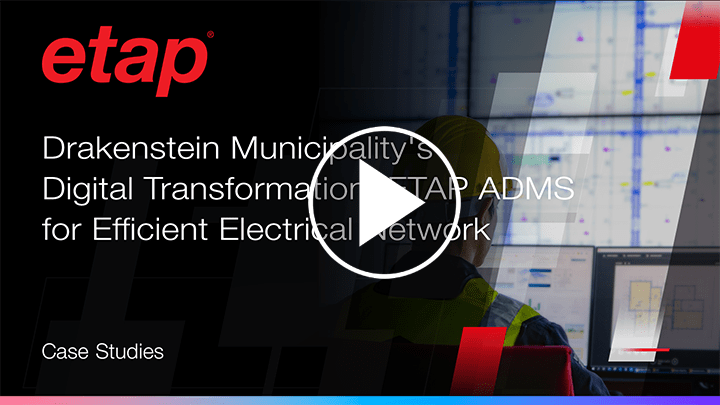
Drakenstein Municipality's Digital Transformation: ETAP ADMS for Efficient Electrical Network
- 10:47
- Case Study
Drakenstein is a municipality in the western Cape province of West Africa supporting the electrical needs of 5 towns and close to 300,000 people. With limited visibility for our existing electrical network, the decision was made to upgrade the legacy equipment. With this, our vision is to embark on a digital journey to improve network efficiencies, reduce downtime, time of outages, and inadvertent tripping. In this case study, the phased approach to this transformation will be discussed, and the use of ETAP applications, analysis modules and the implementation of a digital twin to design and model the new electrical network. The presentation covers the use of ETAP load flow, short circuit, protection and relay coordination studies and subsequent hardware design planning and visualization using ETAP PSMS.

Learn How Weidmueller Improves Manufacturing Efficiency with the SEE Electrical Software Suite
- 16:27
- Case Study
Weidmueller is a pioneer of industrial connectivity, with customers around the world involved in building electrical control cabinets. In this case study, you’ll gain a better understanding of the complexities and bottlenecks in a traditional manufacturing workflow, and how Weidmueller has applied new strategies that work with software solutions such as SEE Electrical to improve efficiency at various phases. The demonstration includes the data engineering connection with ETAP SEE Electrical, SEE Electrical Expert, and SEE 3D Panel+, and how these tools are used by customers to greatly improve wire processing and panel building.

Learn How TVA Uses Python & ETAP for Degraded Voltage Analysis and Motor Starting in Nuclear Plants
- 10:29
- Case Study
Nuclear plants in the United States are governed by federal regulations requiring that the electrical power system provide sufficient capacity and capability to the nuclear plant. As part of this analysis, traditional approaches to manually perform single motor start calculations can be tedious and time-consuming. Also, the manual evaluation of the data can easily introduce errors. This presentation takes a closer look at degraded voltage relays (DVRS) and an approach to simulation used by the TVA that is holistic, using ETAP to easily combine the study cases, the revisions, and the configurations into repeatable studies. The demonstration includes the use of an efficient solution using Python code with ETAP to run the studies and evaluate the resultant data.

How ETAP is Used to Optimize Electrical Systems and Improve Asset Management at Kuwait Oil Company
- 11:08
- Case Study
This presentation discusses the Electrical Information Management System (EIMS) in use at Kuwait Oil Company, a power reservation model-based integration solution designed for oil and gas production. The aim was to achieve flexible and configurable approval workflows, integrated with user access management and various notification methods, to optimize operation, enhance visualization, and improve asset management within their complex electrical networks. Their EIMS integrates smart meters with ETAP and GIS, enabling efficient communication, real-time updates, and enhanced reliability of the electrical system. The pilot project includes real-time power monitoring, reduced site visits, expedited workflow, and centralized management of work order processes. The presentation also covers the challenges faced in power reservation planning and the specific ETAP solutions implemented, including NetPM and ETAP eWeb.

Schneider Electric's Transformation: Enhancing Manufacturing Efficiency with SEE Electrical
- 17:52
- Caso de estudio
Recognizing an opportunity to improve quality and manufacturing efficiency, Schneider Electric Power System North America sought an integrated approach to electrical design and wiring processes. They found the solution in ETAP SEE Electrical and began their transformation journey. In this demonstration, you’ll learn how Schneider Electric evaluated new methods against existing workflows. As a result, SEE Electrical Expert and SEE 3D Panel+ are now being implemented in manufacturing facilities to deliver more robust engineering designs, while SEE One Panel has been adopted to automate manufacturing with wiring machines.

How to Creating a Collaborative Model Using ETAP NETPM
- 20:57
- Case Study
This presentation explores the critical role of ETAP's Network Project Manager (NETPM) in creating collaborative models for power systems. It addresses the industry-wide challenge of maintaining accurate, up-to-date electrical system data, highlighting the risks associated with outdated or inaccessible information. Carter Sanders introduces NETPM as a solution, demonstrating how it facilitates the creation of "living models" that evolve with the system. Key topics include the implementation of NETPM, focusing on user roles, permissions, and effective workflows. A customer success story illustrates the tangible benefits of NETPM, including reduced man-hours, faster information transfer, and improved risk mitigation. The presentation also covers important considerations for model management, data access, and adapting service models to incorporate NETPM effectively. By emphasizing the shift from static diagrams to dynamic, collaborative models, this talk aims to showcase how NETPM can enhance safety, reliability, and efficiency in power system management. It concludes by encouraging audiences to explore NETPM's potential in their operations, positioning it as a crucial tool for navigating the complexities of modern electrical systems.
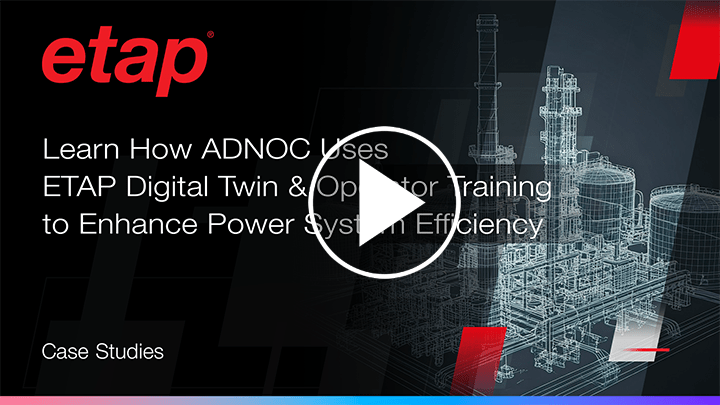
Learn How ADNOC Uses ETAP Digital Twin & Operator Training to Enhance Power System Efficiency
- 17:24
- Case Study
The Abu Dhabi National Oil Company, also known as ADNOC, is the state-owned oil company of the United Arab Emirates, and is the world's 12th largest oil company by production. ADNOC is committed to sustainability and has implemented various initiatives to reduce its carbon footprint, enhance operational efficiency, and support the UAE's goal for renewable energy and climate change mitigation. For ADNOC’s many facilities, whether independent power plants or other electrical networks, the challenge is how to provide training to operators, to not only get familiar with the operation management tools and procedures, but also to gain experience with the system response. In this presentation, ADNOC will demonstrate how they use ETAP Operator Training (eOTS) with ETAP Digital Twin as their training environment for the existing power management system to ensure well-trained operators for their electrical networks, turbines, and generators, and to ensure they are capable of responding to any operating scenarios they face on a day-to-day basis, during a plant startup or shutdown, or any kind of disturbance in the electrical network.

How Marine Electricals utilizes SEE Electrical Software to Streamline Electrical Projects
- 10:22
- Caso de estudio
Marine Electricals India Limited, a premier provider of electrical solutions for marine and industrial applications, has been at the forefront of the industry since its inception in 1978. Headquartered in Mumbai, India, the company specializes in delivering comprehensive electrical systems and services, including design, installation, and maintenance, to a diverse clientele spanning shipping, offshore, and industrial sectors. Before adopting SEE Electrical software, Marine Electricals faced several challenges, including frequent design checks and verification, prolonged project turnaround times, and difficulties in managing complex wiring projects. These issues often led to delays and increased costs, affecting overall efficiency. To address these challenges and enhance its engineering capabilities, Marine Electricals adopted SEE Electrical software. Initially starting with just one license, the company quickly realized the software's potential and has since expanded to 15 licenses. SEE Electrical CAD tool revolutionized their design processes by providing intuitive, user-friendly interfaces and robust features tailored to the needs of electrical engineering. The software enabled seamless creation of detailed schematics, efficient management of complex wiring projects, and ensured compliance with industry standards. By integrating SEE Electrical software into their operations, Marine Electricals significantly reduced design errors and project turnaround times. The software's advanced functionalities facilitated precise documentation and improved collaboration among engineering teams, ultimately leading to enhanced productivity and higher-quality outputs. This strategic adoption has empowered Marine Electricals to deliver more reliable and efficient electrical solutions, reinforcing their reputation as a leader in the marine and industrial electrical sectors.

Learn How ETAP Transforms Long Power Study Reports into Engaging, Interactive Presentations
- 19:36
- Case Study
In most cases, SCCAF (Short Circuit Coordination Arc Flash) studies are done by engineering firms, which then submit reports to facility owners. The challenge is that those reports tend to be lengthy (up to 5,000 pages), not engaging, and hard to grasp for facility personnel. ETAP's powerful graphical and presentation tools can help make those reports livelier, informative, and more engaging. This case study will discuss how you can summarize lengthy power studies reports within just a 30-minute interactive meeting, and highlight how the final ETAP model can be used, with its powerful graphical interface and presentation tools, including Data Blocks, Multiple Presentation layers, Sequence of Operations, and Arc flash calculator.

How BBraun Medical Uses ETAP Intelligent Load Shedding for Uninterrupted Healthcare Operations
- 7:24
- Case Study
This case study discusses the challenges faced by BBraun Medical, a manufacturing facility of medical products, due to unplanned outages and the lack of an optimized load shedding system. This demonstration discusses the use of ETAP Real-Time Intelligent Load Shedding (ILS), and ETAP's digital twin modeling capabilities, to distinguish between different subsystems and validate the ILS solution. The ILS solution provided a quick response to islanding conditions, ensuring the continuous operation of critical loads while shedding non-critical loads, thus minimizing production loss during outages. The solution also offered load optimization, flexible load priority modifications, and real-time monitoring capabilities. Overall, the ETAP ILS solution helped BBraun Medical operate safely during disturbances and minimize the impact of utility disturbances, providing an effective load shedding solution.

How Gila Al-Tawakol Transformed Panel Manufacturing with SEE Electrical to Smarter, Reliable Designs
- 17:04
- Caso de estudio
Gila Al-Tawakol electric, an electrical solutions provider and panel builder, started their digitization transformation by switching from a general CAD software program to SEE Electrical. In order to satisfy the increasing need for specialist electrical design capabilities, this change was crucial. In order to guarantee a seamless transition, our change management strategy included thorough training programs, active stakeholder participation, and a phased implementation approach was essential to this process. This product demonstration discusses this journey, overcoming early resistance, encouraging a culture of continual development, and utilizing SEE Electrical's cutting-edge capabilities to increase our design accuracy and efficiency. This presentation reveals how this change is leading to more innovation and quality in our industry by streamlining our operations, reducing errors, shortening project timelines, and most importantly exploring new customizations and enhancements.

How Unbalanced Harmonics from EV Charging Stations Impact Supply & Distribution Equipment
- 21:57
- Case Study
The escalating demand for fleet electrification across the U.S. presents a significant challenge to existing distribution infrastructure, necessitating EV charging management strategies to meet electrical energy demands and address power quality issues. Level 2 and Level 3 EV chargers, equipped with power electronic converters and PWM technology, generate non-sinusoidal currents, exacerbating power quality concerns at individual sites. The effect of rapid voltage changes (RVC) introduced by this equipment is also discussed. This case study features insights and observations from field-recorded measurements of unbalanced (per-phase) harmonic distortions at a site with over 300 electric van charging stations. The unbalanced harmonic analysis (UBHA) conducted by Eradeh Power Consulting using ETAP Software for the site, revealed distortion limits being exceeded for individual phase currents and voltages as well as power distribution equipment rating overloads (such as transformer K-rating and cable thermal limits). The presentation also discusses how unbalanced harmonic distortions calculated within the site and at the point of common coupling (PCC) can be mitigated using techniques such as the use of active / passive harmonic filters amongst others.

How Nexamp Energy uses ETAP for higher quality and accuracy DC Arc Flash Analysis in BESS
- 23:38
- Case Study
Engineers face unique challenges when calculating DC Arc Flash incident energy for Battery Energy Storage Systems (BESS). Battery short circuit current is highly variant, and factors such as battery chemistry, and how the installation arrangement of BESS have significant differences in short circuit behavior. As well, traditional methods of calculating DCAF have been determined to fall short when it comes to BESS. In this demonstration, these variations will be discussed, including PPE considerations. Following this, a demonstration of the Transient DC Arc Flash solution provided by ETAP solutions will be presented. The presentation will show the usefulness of model validation, and the importance of high quality analysis methods to provide better accuracy in DC AF analysis for BESS.
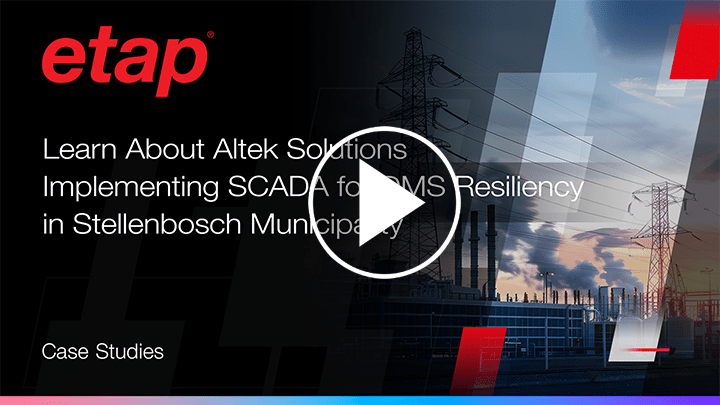
Altek Solutions가 스텔렌보스 지방자치단체에서 DMS 복원력을 위해 SCADA를 어떻게 구현했는지 알아보세요.
- 20:09
- Case Study
스텔렌보스 지방자치단체는 남아프리카 공화국 서부 케이프 주에 위치하며 200,000명 이상의 고객에게 서비스를 제공합니다. 이들은 제어 센터에 SCADA 마스터 스테이션을 구축하여 배전망을 감독하고 운영하는 데 필요한 엔드투엔드 지원을 제공할 유능한 OEM 파트너를 찾고 있었습니다. 또한, SCADA 마스터 스테이션 시스템 구성을 준비하고 완전히 통합된 변전소 보호 및 제어 솔루션을 구현하는 데 도움이 필요했습니다.
Altek Solutions(남아프리카 공화국의 ETAP 시스템 통합업체)의 도움으로, 이 프로젝트는 고객의 목표를 달성하기 위해 실행되었습니다. 이 시연은 여러 단계로 구현된 지방자치단체 제어 센터의 새로운 SCADA 마스터 스테이션에 대해 설명합니다. 첫 번째 단계는 제어 센터에 SCADA를 구축하고 7개의 변전소를 연결하는 것이었습니다. 다음 단계는 SCADA 시스템에 DMS(배전 관리 시스템) 및 OMS(운영 관리 시스템) 기능을 추가하는 것입니다.
ETAP은 모듈식 및 확장 가능한 플랫폼으로, ETAP SCADA 시스템을 기반으로 미래에 필요한 배전 관리 시스템을 쉽게 구축할 수 있기 때문에 이 단계에 선정되었습니다.

